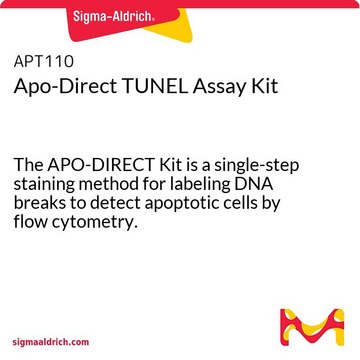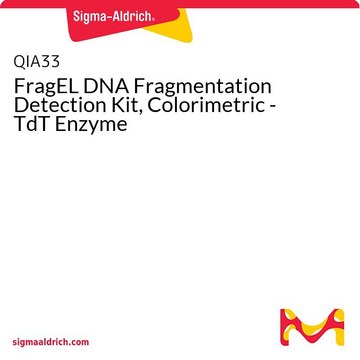11684809910
Roche
In Situ Cell Death Detection Kit, AP
sufficient for ≤50 tests, kit of 1 (3 components), suitable for detection
Sinonimo/i:
cell death kit
About This Item
Prodotti consigliati
impiego
sufficient for ≤50 tests
Livello qualitativo
Confezionamento
kit of 1 (3 components)
Produttore/marchio commerciale
Roche
tecniche
immunohistochemistry: suitable
applicazioni
detection
Temperatura di conservazione
−20°C
Categorie correlate
Descrizione generale
Contents:
- Enzyme Solution (TdT)
- Label Solution (fluorescein-dUTP)
- Converter AP (anti-fluorescein antibody-AP), ready-to-use
Specificità
Applicazioni
- Detection of individual apoptotic cells in frozen and formalin-fixed tissue sections in basic research†
- Determination of sensitivity of malignant cells to drug-induced apoptosis in cancer research
- Typing of cells undergoing cell death in heterogeneous populations by double staining procedures
Caratteristiche e vantaggi
- Sensitive: The maximum intensity of labeling (cell staining) of apoptotic cells is higher than the nick translation method
- Fast: The use of fluorescein-dUTP allows analysis of the samples directly after the TUNEL reaction, but before the addition of the secondary detection system
- Convenient: The direct labeling procedure using fluorescein-dUTP allows verification of the efficiency of the TUNEL reaction during the assay procedure
- Accurate: Identification of apoptosis at a molecular level (DNA-strand breaks) and identification of cells at the very early stages of apoptosis
- Flexible: No substrate included; provides the opportunity to select the staining procedure of choice
Confezionamento
Specifiche
The hallmark of apoptosis is DNA degradation, which in early stages is selective to the internucleosomal DNA linker regions. The DNA cleavage may yield double-stranded and single-stranded DNA breaks (nicks). Both types of breaks can be detected by labeling the free 3′-OH termini with modified nucleotides (e.g., biotin-dUTP, DIG-dUTP, fluorescein-dUTP) in an enzymatic reaction. The enzyme terminal deoxynucleotidyl transferase (TdT) catalyzes the template-independent polymerization of deoxyribonucleotides to the 3′-end of single- and double-stranded DNA. This method has also been termed TUNEL (TdT-mediated dUTP-X nick end labeling). Alternatively, free 3′-OH groups may be labeled using DNA polymerases by the template-dependent mechanism called nick translation. However, the TUNEL method is considered to be more sensitive and faster.
Sample material: Cytospin and cell smear preparations, adherent cells grown on slides, and frozen and paraffin-embedded tissue sections.
Principio
Apoptotic cells are fixed and permeabilized. Subsequently, the cells are incubated with the TUNEL reaction mixture that contains TdT and fluorescein-dUTP. During this incubation period, TdT catalyzes the addition of fluorescein-dUTP at free 3′-OH groups in single- and double-stranded DNA. After washing, the label incorporated at the damaged sites of the DNA is marked by an anti-fluorescein antibody conjugated with the reporter enzyme alkaline phosphatase. After washing to remove unbound enzyme conjugate, the AP retained in the immune complex is visualized by a substrate reaction.
Nota sulla preparazione
Mix well to equilibrate components.
Storage conditions (working solution): TUNEL reaction mixture
The TUNEL reaction mixture should be prepared immediately before use and should not be stored. Keep TUNEL reaction mixture on ice until use.
Converter-AP
Once thawed the Converter-AP solution should be stored at 2 to 8 °C (maximum stability
6 months).
Note: Do not freeze.
Altre note
Solo come componenti del kit
- Enzyme Solution (TdT)
- Label Solution (fluorescein-dUTP)
- Converter AP (anti-fluorescein antibody-AP) ready-to-use
Avvertenze
Danger
Indicazioni di pericolo
Consigli di prudenza
Classi di pericolo
Aquatic Chronic 2 - Carc. 1B Inhalation - Skin Sens. 1
Codice della classe di stoccaggio
6.1D - Non-combustible acute toxic Cat.3 / toxic hazardous materials or hazardous materials causing chronic effects
Classe di pericolosità dell'acqua (WGK)
WGK 3
Punto d’infiammabilità (°F)
does not flash
Punto d’infiammabilità (°C)
does not flash
Certificati d'analisi (COA)
Cerca il Certificati d'analisi (COA) digitando il numero di lotto/batch corrispondente. I numeri di lotto o di batch sono stampati sull'etichetta dei prodotti dopo la parola ‘Lotto’ o ‘Batch’.
Possiedi già questo prodotto?
I documenti relativi ai prodotti acquistati recentemente sono disponibili nell’Archivio dei documenti.
I clienti hanno visto anche
Articoli
Cellular apoptosis assays to detect programmed cell death using Annexin V, Caspase and TUNEL DNA fragmentation assays.
Il team dei nostri ricercatori vanta grande esperienza in tutte le aree della ricerca quali Life Science, scienza dei materiali, sintesi chimica, cromatografia, discipline analitiche, ecc..
Contatta l'Assistenza Tecnica.










